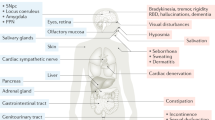Abstract.
The synucleinopathy known as idiopathic Parkinson's disease (IPD) is a multi-system disorder in the course of which only a few predisposed nerve cell types in specific regions of the human brain become progressively involved. The underlying neuropathological process (formation of proteinaceous intraneuronal inclusion bodies) intracerebrally begins in clearly defined induction sites and advances in a topographically predictable sequence. Components of the autonomic, limbic, and motor systems sustain especially heavy damage. During the presymptomatic stages 1 and 2, the IPD-related inclusion body pathology remains confined to the medulla oblongata and olfactory bulb. In stages 3 and 4, the substantia nigra and other nuclear grays of the midbrain and basal forebrain are the focus of initially subtle and, then, severe changes. The illness reaches its symptomatic phase. In end-stages 5 and 6, the pathological process encroaches upon the telencephalic cortex. IPD manifests itself in all of its dimensions, which under the influence of the supervening cortical pathology are subject to increasing complexity.
Similar content being viewed by others
Author information
Authors and Affiliations
Additional information
Correspondence to H. Braak, M. D.
Rights and permissions
About this article
Cite this article
Braak, H., Del Tredici, K., Bratzke, H. et al. Staging of the intracerebral inclusion body pathology associated with idiopathic Parkinson's disease (preclinical and clinical stages). J Neurol 249 (Suppl 3), iii1–iii5 (2002). https://doi.org/10.1007/s00415-002-1301-4
Issue Date:
DOI: https://doi.org/10.1007/s00415-002-1301-4




